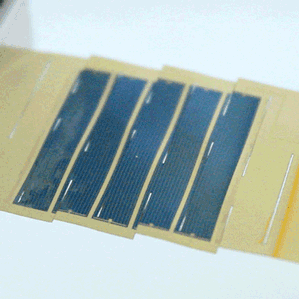How solar panels could capture a lot more sunlight on slanted roofs

Most of the solar panels in the world sit on rooftops at a fixed angle, so they miss out on capturing energy during parts of every day. Now researchers have shown that by cutting solar cells into specific designs using kirigami, a variation of origami which entails cutting in addition to folding, they can allow the cells to track the sun's angle without having to tilt the whole panel. This could have a substantial payoff: solar panels with tracking mechanisms can generate 20 to 40% more energy per year than those without trackers.
As shown in the video below, applying a specific kirigami cut creates strips in a solar cell. Pulling the two ends in opposite directions causes the strips to tilt and assume a desired angle. Crucially, the structure morphs in such a way that prevents the individual strips from casting shadows on the others, and the "waviness" of the new form does not detract from performance, says Max Shtein, a professor of materials science and engineering at the University of Michigan. Shtein led the research along with Stephen Forrest, also a professor of materials science and engineering at the University of Michigan.

The kirigami-based approach makes it possible to generate more electricity while using the same amount of semiconducting material, and accomplishes this to nearly the same degree that conventional tracking systems do, says Shtein. Today's tracking systems, featured in only a small portion of the world's solar power installations, are cumbersome and can be costly. And they function by tilting the whole panel. That doesn't work on most pitched rooftop systems, which account for more than 80% of all installations.
The newly demonstrated device, which features flexible solar cells made of gallium arsenide, is only a proof-of-principle. Developing a technology practical enough for commercial application will take a lot more work. The researchers will likely need to come up with a system for encasing the structures to protect them against the weather and provide mechanical support, and may add electric motors to pull the cells apart at specific times during the day. "It doesn't take much force at all," says Shtein. He says that although the approach is best suited for thin, flexible materials, in principle it could work with "almost any kind of solar cell."




